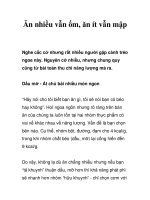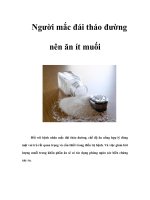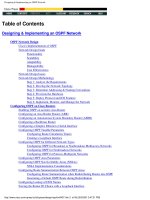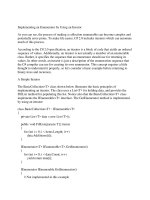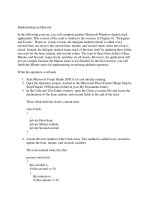Implementing an effective strategic renewal process an IT enabled agility perspective
Bạn đang xem bản rút gọn của tài liệu. Xem và tải ngay bản đầy đủ của tài liệu tại đây (2.84 MB, 185 trang )
i
Implementing an Effective Strategic Renewal
Process - An IT-enabled Agility Perspective
GOH CHONG LENG
(Master of Science, National University of Singapore, Singapore)
A THESIS SUBMITTED FOR THE DEGREE OF DOCTOR OF PHILOSOPHY
DEPARTMENT OF INFORMATION SYSTEMS
NATIONAL UNIVERSITY OF SINGAPORE
2012
i
ACKNOWLEDGEMENTS
The journey towards a PhD degree is an enduring and difficult one. It requires great
determination and perseverance. It is not for the faint of heart, especially not for someone
who is taking this journey on a part-time basis. Hence, I have a lot of people who I am
deeply indebted to at the end of my PhD journey. People who have helped, in one way or
another, to make this journey of getting the illusive „Dr‟ title an enriching and enjoyable
one. The first person that I would like to thank is Professor Ooi Beng Chin, who is my
Masters degree supervisor. He is one of the main reasons why I am determined to pursue
a PhD. From him, I have learnt the importance of „timing‟. Without the right „timing‟ to
allow the development of my intellectual abilities, the journey towards my PhD would be
suicidal. If his timely advice of telling me that I was unsuitable to take up PhD studies in
2000 hadn‟t occurred, I would have most certainly been „dead‟ by now for attempting a
PhD when I was not ready. He is partly the reason I have developed a „never-say-die‟
attitude in every endeavor in my life.
The second and most important person that I am immensely grateful to is Professor Pan
Shan Ling. Professor Pan Shan Ling is more than a teacher. He is a great mentor and a
close friend. Till this date, I am still puzzled over Professor Pan‟s decision to admit a
PhD student like me, who is academically not so strong, into his arms. For whatever the
reason, I have to sincerely thank him for making a bet on me. It is for this reason that I
have always worked really hard to repay his willingness and kindness to accept me as his
student. Influenced deeply by his selfless sharing of knowledge and resources, I have
excelled in my analytical thinking and conceptualization skills during these four-plus
years of my PhD journey. For that, I am eternally grateful. Furthermore, I have also been
ii
given golden opportunities to visit many large corporations in China. I know that such
opportunities are privileges restricted to only a few selected PhD students. I can‟t
possibly imagine the kind of obstacles that I would have to go through to get my PhD
without Professor Pan‟s hard work to secure such quality case accesses for me. Under his
wing, I have been able to see further and venture deeper into the world of knowledge with
passion. I truly treasure every opportunity I have with him and I sincerely hope that I can
continue to have the opportunity to work with and learn from him even after graduation.
Of course, the journey would also not have been enjoyable without the encouragement
and help of many close friends. First, I would like to specially thank my PhD comrades
a.k.a the Pan‟s Mountaineers: Barney Tan, Derek Du, Wang Zheng, Huang Pei Ying,
Sitoe, Li Jia, Carmen Leong, and Mao Mao. Your presence has kept my spirit high on
this long journey. Every moment of interaction with anyone of you has always been
mutually beneficial. Through the many intense interactions with you, I have rekindled my
passion in teaching and learning. If I were to take up a job as an academic in the near
future, each and every one of you would have played a critical role in influencing this
decision. Second, I would like to thank my close friends who have tirelessly helped to vet
my papers and thesis. I know my weak command of the English language has made the
vetting a difficult task but you have done it so willingly and without complaints. Despite
your busy day-to-day work, you have also taken time and effort to give much timely
advice throughout this journey. For that I am deeply grateful. I would particularly like to
thank Candice Khor, Tan Wee Yeh, Goh Shen Tat, and Benny Loh. It has been a great
joy in discussing my PhD experiences with you. Even though I know that my sharing can
iii
be a little dry at times, you have always been patient enough to listen, and kind enough to
interact with me in many fruitful discussions.
Finally, no journey of this great difficulty can be completed without the care, love, and
sacrifice of my family members. To my beloved wife, Jenny, who endured all the bad
temper moments during my „writing‟ days, I would like to let you know that you are the
„fuel‟ behind every endeavor of my life. It is your love that keeps me going when the
going gets tough. It is your care that catches me when I fall and helps me get onto my feet
again. To my parents, god-parents, parents-in-law and brother and sister-in-law who have
silently endured all the months of my not being able to meet up with you amid my busy
work and PhD schedule – I am sorry. I hope that after I have completed this difficult and
long journey I will be able to make up for the lost time with you. I hope what I have
achieved will make your sacrifices worthwhile and that you will be proud of my
achievements. Thank you for your unwavering love, support, and belief in my ability
throughout these four-plus years. I wouldn‟t have been able to complete my PhD without
all this.
iv
SUMMARY
Strategic renewal is increasingly becoming an important and necessary endeavor for an
organization competing in a hypercompetitive environment. In such an environment, an
organization‟s survival depends very heavily on its ability to renew its strategies,
operations, and market relationships in a timely fashion to respond to disruptive
environmental changes and/or to find and capture future opportunities. There are two
types of strategic renewal identified in the extant literature and they are: (1) discontinuous
strategic renewal – denotes a form of renewal that is typically forced by disruptive
changes in the competitive environment and normally requires an organization to renew
itself rapidly; and (2) incremental strategic renewal – denotes a form of renewal that
involves a deliberate attempt by an organization to systematically and incrementally
renew itself to capture potential opportunities in the market. In reviewing the literature of
strategic renewal, we posit that a model detailing the role of IS during the process of
strategic renewal is an important contribution to the extant literature. We argue that IT-
enabled agility is an appropriate theoretical lens to understand the role of IS during the
process of strategic renewal. This is because IT-enabled agility is defined as an
organization‟s ability to sense and respond to opportunities inherent in a
hypercompetitive environment. This ability in turn is aligned with the organization‟s need
to enact strategic renewal.
By conducting two case studies, with each matching a type of strategic renewal identified
in the literature, we attempt to offer an answer to this research question: How can an
effective strategic renewal be implemented within an organization through the
development of IT-enabled agility? In the first case study, we have identified the
v
development of IS development (ISD) agility as the main enabler that has helped Beijing
Capital International Airport (BCIA) rapidly enact an effective discontinuous strategic
renewal implementation for the 2008 Olympics. In the second case study, we have
identified the development of Green Agility (an IT-enabled agility) as the main enabler
that allows China Mobile Communication Co. Ltd to systematically enact an effective
incremental strategic renewal implementation in response to the call for sustainability
actions in business. Various inductive models were derived based on the two case studies,
which provided an in-depth understanding and analysis of the role of IT-enabled agility in
enacting an effective strategic renewal implementation. We conclude by stating the
practical and theoretical contributions of these inductively derived models, the limitations
of the two case studies and some future research directions.
vi
TABLE OF CONTENTS
ACKNOWLEDGEMENTS I
SUMMARY IV
LIST OF TABLES VIII
LIST OF FIGURES X
CHAPTER 1: INTRODUCTION 1
1.1 STUDYING THE ROLE OF IT-ENABLED AGILITY IN A BOTTOM-UP DISCONTINUOUS STRATEGIC RENEWAL PROCESS 6
1.2 STUDYING THE ROLE OF IT-ENABLED AGILITY IN A TOP-DOWN INCREMENTAL STRATEGIC RENEWAL PROCESS 8
1.3 THESIS ORGANIZATION 9
CHAPTER 2: LITERATURE REVIEW 10
2.1 REVIEW ON STRATEGIC RENEWAL 10
2.1.1 Enacting the Effective Strategic Renewal Process at Business Unit Level 13
2.1.2 Enacting the Effective Strategic Renewal Process at Organization Level 15
2.1.3 Gaps in Extant Literature on Strategic Renewal 16
2.2 REVIEW ON IT-ENABLED AGILITY 18
2.2.1 Role of IT in Developing Enterprise Agility at Organization Level 19
2.2.2 Role of IT in Developing IS Development Agility at Project Level 24
2.3 SUMMARY ON LITERATURE REVIEW 25
CHAPTER 3: DEVELOPING ISD AGILITY FOR EFFECTIVE BOTTOM-UP DISCONTINUOUS STRATEGIC
RENEWAL IMPLEMENTATION 26
3.1 INTRODUCTION 26
3.2 THEORETICAL BACKGROUND 31
3.2.1 AGILE IS DEVELOPMENT PRACTICES 31
3.2.2 TRUST-MEDIATED ORGANIZATION CONTROL & IT CAPABILITIES 36
3.3 RESEARCH METHODOLOGY 40
3.4 CASE DESCRIPTION 45
3.4.1 Airport Departure System 46
3.4.2 Airport Operation Database (AODB) System 50
3.4.3 Airport Security System 54
3.4.4 Airport Data Centre System 58
3.5 DISCUSSION 62
3.5.1 Airport Departure System Case Analysis 66
3.5.2 Airport Operation Database System Case Analysis 70
3.5.3 Airport Security System Case Analysis 73
3.5.4 Airport Data Centre Case Analysis 76
3.5.5 Cross Case Analysis 80
3.6 CONCLUSION 81
CHAPTER 4: DEVELOPING GREEN AGILITY FOR EFFECTIVE TOP-DOWN INCREMENTAL STRATEGIC
RENEWAL 84
4.1 INTRODUCTION 84
4.2 LITERATURE REVIEW 89
4.2.1 Environmental Sustainability and Green IS 89
4.2.2 Theoretical Foundation: IT-enabled Agility and Belief-Action-Outcome Framework 92
4.3 RESEARCH METHODOLOGY 95
4.4 CASE DESCRIPTION 106
4.4.1 The Sustainability Movement in China 106
4.4.2 The Green Action Plan 109
vii
4.4.3 The Implementation of the Green Action Plan 110
4.5 DISCUSSION 121
4.6 CONCLUSION 145
CHAPTER 5: CONCLUSION 150
5.1 FINDINGS RELATED TO THE STRATEGIC RENEWAL PROCESS 150
5.1.1 Beijing Capital International Airport (BCIA) Terminal 3 IT Implementation 150
5.1.2 China Mobile Communications Co Ltd’s Green IS Initiative 151
5.2 THEORETICAL AND PRACTICAL CONTRIBUTIONS 152
5.3 LIMITATIONS AND FUTURE RESEARCH 153
REFERENCES 155
APPENDIX A: SELECTED BEIJING TERMINAL 3 CASE PHOTO ARCHIVE 165
APPENDIX B: SELECTED CHINA MOBILE CASE PHOTO ARCHIVE 168
viii
LIST OF TABLES
Table 1: Empirical Studies on the Process of Strategic Renewal 12
Table 2: Types of Digital Options (Sambamurthy et al. 2003) 20
Table 3: Key Principles and Practices of Practitioners‟ Agile Approaches/Methods (From
(Lee et al. 2010)) 31
Table 4: What Constitutes Agility in IS Development (Adapted from (Lee et al. 2010)) 32
Table 5: Taxonomy of an Agile IS Development Practice (From (Conboy 2009)) 34
Table 6: Definition of Control Modes (Adapted from (Kirsch 1997)) 37
Table 7: Details of Interviews Conducted 41
Table 8: Detailed Description of Mission-Critical Systems Featured in this Study 43
Table 9: Steps to Ensure Construct Reliability and Validity (Adapted from (Ravishankar
et al. 2011; Yin 2009)) 45
Table 10: Representative Quotations on Airport Departure System Case Data 49
Table 11: Representative Quotations on the Airport Operation Database System‟s Case
Data 52
Table 12: Industry Standard Five-Level Security Screening Processes (From (Airport-int
2009)) 54
Table 13: Representative Quotations of Airport Security System‟s Case Data 56
Table 14: Representative Quotations of Case Data for the Airport Data Centre System . 61
Table 15: Project Uncertainty Classification for Each IT Project in Our Case Data 62
Table 16: Summary of Constructs and their Definitions Used in Models 65
Table 17: Types of Agile IS Development Practices 80
Table 18: Conforming to the Taxonomy of Agile IS Development Practices 81
Table 19: Role of IT (Adapted from Dao et al. [31]) 95
Table 20: Generating rich and thick descriptions from interviewing techniques (Adapted
from (Schultze et al. 2011)) 97
Table 21: Summary of Data Collected and Interviewees‟ Profiles of Our Study 101
ix
Table 22: Steps to Ensure Reliability and Validity in China Mobile‟s Study (Format
Adapted from (Ravishankar et al. 2011)) 104
Table 23: Milestones of China Mobile‟s CSR (From (China-Mobile 2010b)) 107
Table 24: Milestones of Green Action Plan (Adapted from (China-Mobile 2010a)) 110
Table 25: Trend of Green Action Plan Project‟s KPIs from 2006 to 2010 111
Table 26: Selected Examples of IT-Enabled Innovations Launched at China Mobile 116
Table 27: Relevant Observations and Constructs at Strategic Level 127
Table 28: Relevant Observations and Constructs at Operational Level 132
Table 29: Relevant Observations and Constructs at Market Level 138
x
LIST OF FIGURES
Figure 1: Airport Departure System - Precision-based Agile IS Development Practices 69
Figure 2: Airport Operation Database System – Preemptive-based Agile IS Development
Practices 72
Figure 3: Airport Security System - Adeptness-based Agile IS Development Practices . 75
Figure 4: Airport Data Centre System - Improvement-based Agile IS Development
Practices 79
Figure 5: Coding Techniques Used Case Analysis 102
Figure 6: Summary of Discussion 144
Figure 7: Process Model Depicting How to implement an Effective Green IS Initiative
through IT-enabled Balancing and Resource-leveraging Capabilities (a.k.a Green Agility)
146
Figure 8: Future Research Directions 154
Figure 9: Beijing Capital International Airport Terminal 1, 2 and 3 Actual Size
Comparison (Map Courtesy of Search Result from Google Maps) 165
Figure 10: Site Visit to Terminal Command Centre in BCIA 165
Figure 11: Actual Interview Photo in BCIA 166
Figure 12: Secondary Materials and Researcher‟s Observation Notes Captured during
Case Study 167
Figure 13: Descriptions of Green Targets Set for China Mobile 168
Figure 14: Descriptions of Technologies Used in the China Mobile‟s Green Data Centre
168
Figure 15: Descriptions of Innovations & Green Initiatives to Develop Green Ecosystem
169
Figure 16: Descriptions of China Mobile‟s Patents on Green Technologies Used 169
Figure 17: 2008 China Green IT Enterprise Award for China Mobile 170
Figure 18: Models to Illustrate the Green Design of its Base Station & Building 170
Figure 19: Intelligence Green Cooling System Installed at Roof Top of China Mobile‟s
Beijing Subsidiary Office 171
xi
Figure 20: Site Visit to China Mobile‟s Customer 171
Figure 21: Books, Independent Audit Report, Annual Reports and Other Secondary
Materials Collected Before, During, and After Case Interviews 172
Figure 22: Diagrams that Capture „Logical Chain of Evidence‟ of How the Theoretical
Model was Inductively Derived 173
1
CHAPTER 1: INTRODUCTION
Brought forth by the forces of globalization and technology changes, the business
competitive environment has been dynamically transformed (Agarwal et al. 2009). It is
not uncommon for an organization competing today to face the frequent emergence of
disruptive technologies, acute changes of regulatory requirements, intense time-to-market
pressures, and rapidly changing customer preferences, which in turn threaten its ability to
survive and thrive (D'Aveni 1995). Many researchers have deemed this competitive
environment phenomenon as hypercompetitive and there is general consensus that such a
hypercompetitive environment has increasingly become the norm of today‟s business
environment in all industries (D'Aveni 1995; D'Aveni et al. 2010; Glenn 2009; Hamel et
al. 2003; Sargut et al. 2011; Tanriverdi et al. 2010; Thomas Iii 1996). This consensus is
best supported by some of the observations illustrated in several research papers: (1)
sustained superior corporate performance is very rare across many industries even among
the S&P 500 companies (Hamel et al. 2003; Tanriverdi et al. 2010; Wiggins et al. 2005);
and (2) the duration on which successful companies can sustain the window of
profitability has been shrinking over the years (Hamel et al. 2003; Wiggins et al. 2005).
One of the key reasons as to why it is so difficult to survive in a hypercompetitive
environment is because strategy formation and implementation has become a very
complicated and complex endeavor (Camillus 2008). The traditional process of strategy
formation and implementation that focuses on a „position defense‟ strategy (such as
Porter‟s five forces analysis) is deemed as ineffective in a hypercompetitive environment,
because the „position‟ for organizations to defend has become dynamic and unpredictable
in this environment (Camillus 2008; Tanriverdi et al. 2010). To survive and thrive in a
2
hypercompetitive environment, researchers have advocated that the focus on the illusive
„position‟ defense strategy should be dropped (D'Aveni et al. 2010; Tanriverdi et al.
2010). Instead, an organization should align itself with the environment (Day 2006) and
focus its strategy and resources on developing capabilities which allow them to
consistently and continuously enact effective strategic renewals (Agarwal et al. 2009;
Hamel et al. 2003; Tanriverdi et al. 2010). Strategic renewal is a type of strategic change
that specifically emphasizes the refreshment or replacement of strategic attributes (such
as goals, products and services, resources and capabilities, and the like) of an
organization that have the potential to substantially affect its long-term prospects
(Agarwal et al. 2009). The main difference between strategic change and strategic
renewal is that strategic change may include the extensions, additions or deletions of
strategic attributes of an organization without any associated renewal (Agarwal et al.
2009). However, what constitutes the “refreshment” or “replacement” of a strategic
attribute of an organization?
Agarwal et al. (2009) have identified several natures of “refreshment” or “replacement”
during a strategic renewal process. First, they posit that the refreshment or replacement of
strategic attributes does not mean that the original attributes must be refreshed or
replaced to their pre-refreshment or pre-replacement state. Second, they advocate that the
refreshment or replacement of a strategic attribute may be partial or full, which implies
that the organization may choose to retain useful parts of the original strategic attribute
and refresh or replace only the other parts of that attribute. Third, they highlight that the
original strategic attribute of an organization may be extended beyond its original size or
scope of application through the refreshment and replacement process. Finally, they
3
postulate that the refreshment process can be done through reconfigurations of the current
attributes with or without any additions or deletions. They further explain that strategic
renewal can be examined from three dimensions namely, the process of strategic renewal,
the content of strategic renewal, and the outcomes of strategic renewal. Based on these
characteristics of strategic renewal, they define strategic renewal as “the process, content,
and outcome of refreshment or replacement of attributes of an organization that have the
potential to substantially affect its long-term prospects” (Agarwal et al. 2009, pp 282).
Accordingly, two types of strategic renewal are identified in the literature and they are:
(1) discontinuous strategic renewal; and (2) incremental strategic renewal. Several
conceptual papers (i.e. without support of data) on strategic renewal also suggested that
the process of strategic renewal can be enacted via two approaches, namely top-down
(e.g. Floyd et al. 2000; McGrath et al. 2009) and bottom-up (e.g. Ghoshal et al. 1996;
Whitney 1996). In a top-down approach, a strategic renewal process gets initiated from
the senior management and driven downward across the rest of the organization. In a
bottom-up approach, a strategic renewal process happens at operation level/business unit
and gets proliferate across the whole organization.
Notwithstanding the existing empirical studies done on strategic renewal, our literature
review has revealed several gaps in the extant literature. First, most of the empirical
studies conducted on strategic renewal are focused on identifying the critical factors that
influence the organization‟s decision on enacting a strategic renewal process, such as
organizations‟ R&D innovation behavior (Knott et al. 2009), herd behavior (Stienstra et
al. 2004), industry participants (Kim et al. 2009), and on identifying the factors that
influence the success of a strategic renewal process, such as organizational learning
4
(Crossan et al. 2003), selection capability (Capron et al. 2009), compensatory fit between
formal and informal organization in a firm (Gulati et al. 2009), and context-specific
managerial cognition (Eggers et al. 2009). While the identification of these factors is an
important contribution to the extant literature, it is insufficient to provide a rich and in-
depth understanding of the process to enact an effective strategic renewal. Specifically,
an investigation on how to implement an effective strategic renewal process to detail and
clarify the intertwining relationships between people, processes, and IT is unlikely to be
uncovered through research which focuses purely on identifying critical factors. The
proliferation of hypercompetitive-ness across all business competitive environments has
also made this inquiry an important undertaking because the answer to this will help to
shed valuable insight on guiding practitioners on how to enact an effective strategic
renewal process. Second, none of the studies on strategic renewal that we have reviewed
have taken into consideration the role of IT during the strategic renewal process. We
posit that IT is an important consideration to be included in a strategic renewal study
because the effective combination of IT and business resources will derive capabilities
that can help to reduce risks and complexities when implementing a strategic renewal
initiative, and will contribute significantly to its eventual effective implementation. In a
recent call to the IS community, Tanriverdi et al. (2010) reiterate this point of reframing
dominant IS strategy research from a focus on the sustained competitive advantage
objective to an emphasis on understanding the role of IT and IT-enabled capabilities in
the process of strategic renewal. This attests to our postulation on the importance and
lack of empirical study in this area in the extant literature on strategic renewal. These
gaps in the extant literature motivate the development of this thesis.
5
Several IS researchers have recognized the development of IT-enabled agility as one of
the key strategies in surviving and thriving in a hypercompetitive environment (e.g. Goh
et al. 2010; Overby et al. 2006; Sambamurthy et al. 2003; Seo et al. 2008; Tan et al.
2010). The development of IT-enabled agility can enhance the richness and reach of an
organization‟s processes and knowledge, which in turn allows that organization to
consistently and rapidly detect and seize opportunities in a hypercompetitive market
(Sambamurthy et al. 2003). Implicitly, this suggests that the development of IT-enabled
agility is the enabler and foundation for the enactment of effective strategic renewal
implementation. Our assertion is best summarized in the words of Mathiassen and Pries-
Heje (2006) where they described IT-enabled agility as an organization‟s “ability to
quickly change the type and flow of information within an organization” and would
inevitably lead to “a rapid and graceful reorganization” (Mathiassen and Pries-Heje
2006, p. 117). Based on this definition, we see a natural fit of using IT-enabled agility as
a theoretical lens to understand the process on how an effective strategic renewal
implementation can be enacted within an organization.
IT-enabled agility is advocated as having two set of capabilities namely, IT-enabled
sensing capabilities and IT-enabled responding capabilities (Overby et al. 2006). We
posit that these two sets of capabilities can be developed at two distinct levels of an
organization, i.e. enterprise-wise level or project level. At enterprise-wise level, IT-
enabled agility is often known as IT-enabled enterprise agility. At project level, one form
of IT-enabled agility is IS development (ISD) agility. Relating this back to our discussion
on strategic renewal, we have earlier identified that strategic renewal can happen via two
approaches namely, bottom-up and top-down. In the case of the bottom-up approach, we
6
believe the development of ISD agility at project level is the key enabler. Through the
development of IT-enabled sensing and responding capabilities within an IS
development, organizations will acquire the ability to sense the evolving business
requirements accurately and rapidly modify existing, or develop new IT systems to
respond to these business requirements. This facilitates the rapid adoption of these IT
systems that are intended to replace or refresh an organization‟s strategies, operations,
and market relationships during a strategic renewal process. Hence, an effective strategic
renewal process can be achieved through the development of IS development agility. In
the case of the top-down approach, we believe the development of IT-enabled enterprise
agility at enterprise level is the key enabler. Through the development of IT-enabled
enterprise agility, the entire organization can systematically renew its strategies,
operations, and market relationships incrementally through IT in accordance to the
changes in its environment. Based on these two identified approaches, we have designed
and conducted two case studies. The two case studies seek to answer the overarching
research question of this thesis which is: How can effective strategic renewal be
implemented through the development of IT-enabled agility which comprises IT-enabled
sensing and responding capabilities? Each of the studies is designed to investigate into
the role of IT-enabled agility in an effective top-down and bottom-up approach of
enacting a strategic renewal process.
1.1 Studying the Role of IT-enabled Agility in a Bottom-up Discontinuous
Strategic Renewal Process
To understand the role of IT-enabled agility in an effective discontinuous strategic
renewal implementation, we conducted a case study on the Beijing Capital International
Airport (BCIA) Terminal 3 IT program implementation. This study demonstrates how the
7
development of information system development (ISD) agility during the Terminal 3
project enabled BCIA to enact an effective discontinuous strategic renewal of the entire
organization to meet the mandate by the Chinese government for seamless terminal
operations during the 2008 Olympics. Due to the sheer size of the Terminal 3
implementation, it mandated significant replacement and/or refreshment of existing
BCIA strategies, operations, and partner relationships to cope with the large increase in
workload. There was also a „hard‟ deadline to enact an effective strategic renewal.
Missing the deadline was not an option because the nation‟s reputation was at stake.
We posit that ISD agility enables the effective strategic renewal process because as an
organization develops its capability to be agile in its ISD practices, it will become highly
efficient and effective in sensing business requirements, and in creating and/or adapting
its IT systems to meet these requirements. This allows the IT systems to be readily
adopted by the business users, which in turn contributes to the effectiveness of the
strategic renewal process. As all the IT systems in Terminal 3 were realized rapidly due
to the mandatory deadlines, the existing IT-enabled capabilities of managing the airport
terminals in BCIA had been significantly refreshed and enhanced. This in turn allowed
BCIA to achieve great success in ensuring smooth operations during the 2008 Olympic
Games. It should be noted that each of the IT systems was implemented in parallel and
the agile IS development practices were developed organically by the IT department
during the systems implementation in Terminal 3. Hence, we believed that the
development of ISD agility happened in an asynchronous way starting from the IT
department and proliferate across the organization. This is one of the key reasons why we
8
have classified this particular case as a bottom-up discontinuous strategic renewal
process.
1.2 Studying the Role of IT-enabled Agility in a Top-down Incremental
Strategic Renewal Process
To understand the role of IT-enabled agility in a top-down incremental strategic renewal
process, we conducted a study on the implementation of China Mobile Communications
Co. Ltd (China Mobile)‟s Green IS initiative. Green IS is defined as an integrated and
cooperating set of people, processes, software and IT infrastructure to support the firm‟s
efforts in achieving its sustainability objectives (Chen et al. 2009; Watson et al. 2008).
The case study examined China Mobile‟s process of incremental strategic renewal of the
company‟s strategies, operations, and partner relationships towards sustainability. We
assert that this is an incremental strategic renewal process because it was a conscientious
undertaking by China Mobile to align its organization towards the increasing emphasis on
sustainability. While there were some environmental pushes towards sustainability by the
Chinese Government, the process of strategic renewal implementation in China Mobile
required a deliberate balancing between profitability and sustainability in order to effect a
successful strategic renewal process. We have classified this case study as an
investigation of a top-down incremental strategic renewal process because of three
reasons: (1) The need to enact the strategic renewal process in China Mobile was initiated
by senior management with the setup of a special task force at headquarter; (2) this
special task force took measures to influence the management of the subsidiaries of
China Mobile to implement its sustainability effort systematically across China Mobile;
and (3) the management of each subsidiaries translated this senior management‟s intent to
concrete sustainability actions on the ground.
9
In this study, we are interested in identifying the critical IT-enabled sensing and
responding capabilities that allow an organization to systematically renew its strategies,
operations, and market relationships towards sustainability. We posit that these critical
IT-enabled capabilities are closely related to the development of a form of IT-enabled
agility called „green agility‟.
1.3 Thesis Organization
This thesis is organized into five chapters. The first chapter focuses on highlighting the
motivation behind the development of this thesis, and the research question that this
thesis seeks to answer. The second chapter will provide a comprehensive review of the
literature of our phenomenon (strategic renewal) and our theoretical lens (IT-enabled
agility). The third chapter will present our case study on the process of developing ISD
agility in a bottom-up discontinuous strategic renewal process. The fourth chapter will
detail our case study on the process of developing Green Agility in a top-down
incremental strategic renewal process. This is followed by the fifth chapter where the
findings of the two case studies are consolidated and explained in relation to strategic
renewal. The theoretical and practical contributions of the findings, limitations and
opportunities for future research will also be discussed in this chapter.
10
CHAPTER 2: LITERATURE REVIEW
2.1 Review on Strategic Renewal
Agarwal et al. (2009) have identified four critical characteristics of a strategic renewal
process, namely: (1) an organization‟s strategic renewal process must have the potential
to substantially affect the long-term prospects of a company; (2) an organization‟s
strategic renewal includes the process of renewing (process), the quality or state of being
renewed (content), and “something renewed” (outcome); (3) an organization‟s strategic
renewal involves the (partial or full) refreshment or replacement of strategic attributes
(such as goals, products and services, resources and capabilities, etc.) of an organization;
and (4) such refreshment or replacement of strategic attributes is done with the intention
of providing a foundation for future growth or development for the organization. Based
on these identified characteristics, strategic renewal is defined as “the process, content,
and outcome of refreshment or replacement of attributes of an organization that have the
potential to substantially affect its long term prospects” (Agarwal et al. 2009, pp 282).
Two basic types of strategic renewal namely, discontinuous strategic renewal and
continuous/incremental strategic renewal, are identified in the literature (Agarwal et al.
2009).
A discontinuous strategic renewal is typically brought forth by a sudden environmental
change (such as an introduction of disruptive technology) that forces a company to
radically change a large portion of its strategic attributes (such as goals, products and
services, resources and capabilities, etc.) that have been rendered „useless‟ by the change
(Agarwal et al. 2009). Most discontinuous strategic renewal transformations are highly
risky in nature because all, or substantial parts, of an organization will need to be
11
replaced/refreshed, which inevitably leaves an organization vulnerable to failure during
the renewal process (Agarwal et al. 2009). The task of justifying which parts are to be
replaced/refreshed, how much to replace/refresh, when to invoke the
replacement/refreshment process, and how to implement it well given the limited
organization resources at hand are all important considerations during a discontinuous
strategic renewal process. Furthermore, discontinuous strategic renewal of an
organization in a hypercompetitive environment is often time-bound where the
transformation of that organization has to happen quickly and effectively (Wiggins et al.
2005). A continuous/incremental strategic renewal is an incremental enactment of the
strategic renewal process by organizations to keep pace with, or even lead external
environment changes (Agarwal et al. 2009). Incremental strategic renewal is a more
typical response of an organization in a hypercompetitive environment as it involves
lesser risk in development. However, when proactively done over a long period of time,
incremental strategic renewal can have the same impactful results as discontinuous
strategic renewal (Agarwal et al. 2009).
While a research paper may examine any combination of the process, content, and
outcome of strategic renewal in an organization, we are interested in the process of
strategic renewal in this thesis. Our literature review on the process of strategic renewal
has revealed that existing empirical studies have a dominant focus on identifying the
critical factors that will influence the process of renewing, with no or little elaboration on
how an effective strategic renewal process can be implemented in an organization. Table
1 summarizes the list of empirical studies conducted on the process of strategic renewal.
12
Table 1: Empirical Studies on the Process of Strategic Renewal
Empirical Studies Description
Types of Strategic
Renewal
Factors Identified
Factors influencing organization‟s strategic renewal intent
Kim et al. (2009) examined
the role of innovation in
racket design in triggering the
strategic renewal of a mature
tennis racket industry
Continuous/Incremental
strategic renewal
Organizational imitation
and contagion of an
innovation by industry
participants
Knott et al. (2009) identified
R&D as a key mechanism for
strategic renewal and
examined the rate of
replenishment of innovation
assets through firms‟ R&D
efforts and the industry
factors that may influence
this rate
Discontinuous strategic
renewal
The intensity of firms‟
R&D efforts & its
linkage to industry
factors such as market
size, market growth, the
number of rivals, and the
ease of expropriating
spillovers
Stienstra et al. (2004)
examined the effect of „herd‟
behavior of rivals in
influencing the strategic
renewal decision of 5 Europe
largest Telecom operators
Discontinuous strategic
renewal
„Herd‟ behavior of rivals
Factors/Capabilities/Conditions influencing success of a strategic renewal process
Crossan et al. (2003) linked
the 4I framework in
organization learning
literature to explain the
tension between exploration
and exploitation during a
strategic renewal
implementation in Canada
Post Corporation when the
company moved from
physical to electronic delivery
of mail
Discontinuous strategic
renewal
Organization learning
Eggers et al. (2009)
investigated the effect and
influence of context-specific
managerial cognition on the
degree and direction of
strategic renewal of a firm
Discontinuous strategic
renewal
Context-specific
managerial cognition
Capron et al. (2009)
identified a dynamic
capability (called selection
Continuous/Incremental
strategic renewal
Selection Capability
13
capability) in an organization
that allows it to select the
appropriate sourcing mode
during a strategic renewal
process. They argued that the
success of a strategic renewal
process of a firm is
contingent upon this selection
capability
Gulati et al. (2009) identified
compensatory fit between
formal and informal
organization in a firm as one
of the key determinants of
firm‟s ability to enact
effective strategic renewal
Discontinuous strategic
renewal
Formal and informal
organizational structure
and their compensatory
fit
Several observations can be distilled from the review of the extant empirical studies on
strategic renewal. First, most of the researches are conducted in recent years,
demonstrating the nascent stage of existing research. Second, being a relatively new area
of research, the efforts of extant literature have been channeled towards two key areas:
(1) identifying a list of factors that will influence an organization‟s decision to enact a
strategic renewal process (e.g. Kim et al. 2009; Knott et al. 2009; Stienstra et al. 2004);
and (2) identifying factors/capabilities/conditions that are critical to the success of a
strategic renewal process (e.g. Capron et al. 2009; Crossan et al. 2003; Eggers et al. 2009;
Gulati et al. 2009). Beside empirical studies, several conceptual papers that focus on the
process of strategic renewal were also proposed.
2.1.1 Enacting the Effective Strategic Renewal Process at Business Unit Level
One such paper presented the idea that a successful strategic renewal process within a
business unit is dependent on the resolution of role conflicts between “the need to
institutionalize the managerial behavior associated with the current competencies and


